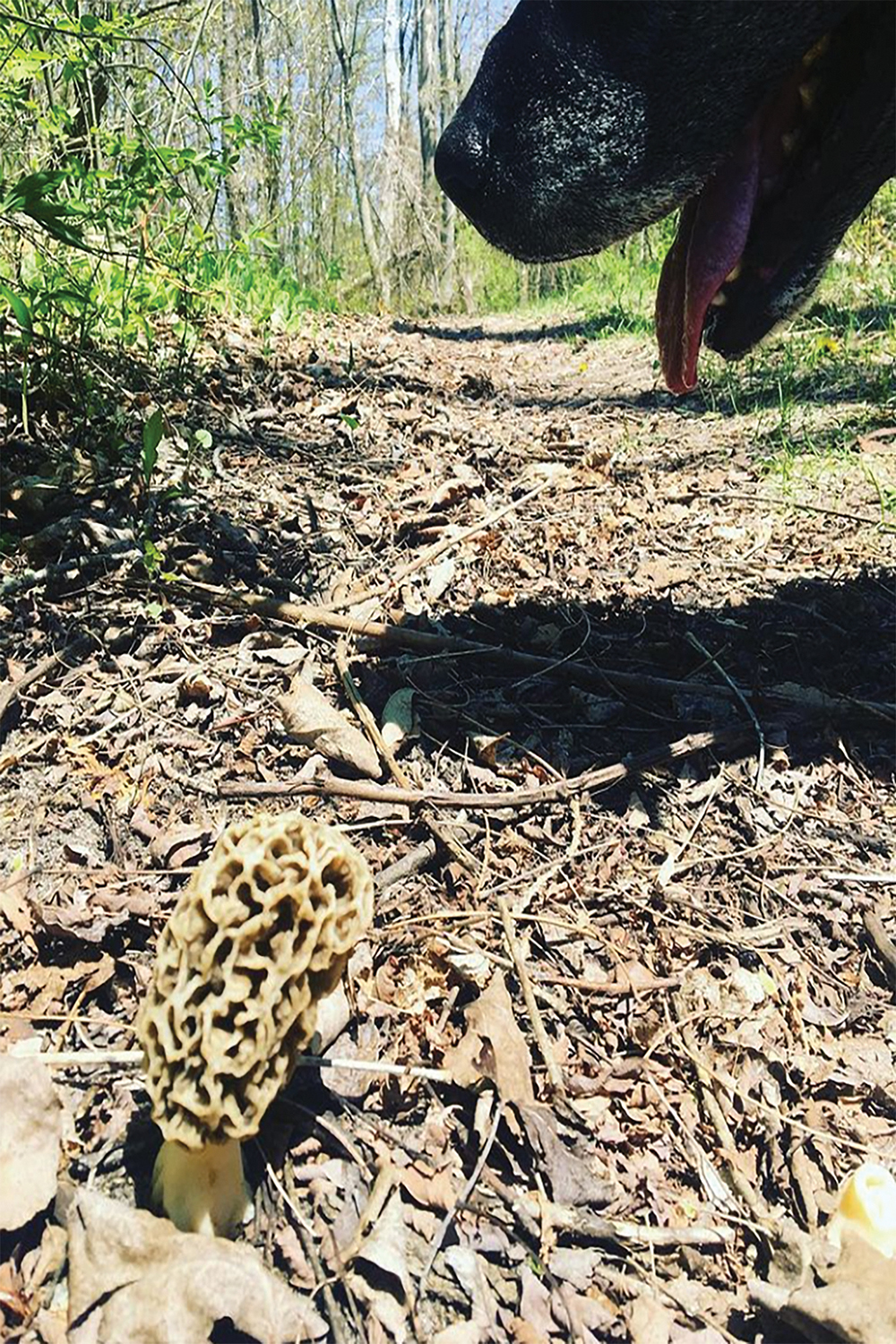Searching for the elusive morel mushrooms
By Sandra Serra Bradshaw
Current Contributor
It is that time of year again, when hordes of hunters head for the woods and fields of Northern Michigan in search of a much sought-after delicacy—the illusive morel mushroom. May is morel month in Michigan, and these wild mushrooms are the rare prize of this annual spring hunt. Not exclusive to Northern Michigan, morels can actually be found in every county in the state. But not just in Michigan, nor only the Midwest; morels have even been found in temperate zones throughout the world, from as far north as Russia and as far south as Australia.
You thought Northern Michigan had the sole claim on morels? Not so! Strangely, morels picked in Pakistan and France are exported to Michigan and U.S. cities, even though they are well-known and hunted here. Additionally, the state of Minnesota recognizes the morel as its “official state mushroom.”
The morel is considered one of the safest mushrooms for eating. Easy to identify, they are actually a large, fleshy fungi belonging to the genus Morchella, Latin for “mushroom.” At least 60—and some sources say up to 100—species have been identified. The five most common in are:
• Morchella angusticeps: the skinny black—and earliest—morel;
• Morchella elata: another black morel, more beefy in size;
• Morchella esculenta: called the “yellow morel” or “common morel”;
• Morchella crassipes: also known as “gigantic morels,” due to their size;
• Morchella americana: the “white” or “gray” morel and the last to appear during the season.
Since the 1970s, scientists have considered the fungi distinct enough from plant life to be placed in their own kingdom, the Mycota. In fact, DNA-based research reveals that fungi are more closely related to animals than to plants. Fungi produce spores rather than seeds for reproduction—which is why any ’shroomer worth their morel should collect them in a net bag, so as to allow the spores to spatter along the ground, and never use plastic bags to carry them, as it speeds their decay.
Though morels can be found just about anywhere, the most popular place for these elusive mushrooms is in forests and areas of scattered trees. A good indicator: if you see trilliums (Trillium grandiflorum), chances are there are morels lurking nearby. Often, old orchards—especially apple, cherry, peach, and pear—that are not being sprayed with fungicides, may have reliable crops of morels. Burned areas frequently produce them, as well.
“Although they can be found in many places, they most often can be found in the forest. They seem to like to grow in maple, basswood, beech, and aspen woods,” explains Suttons Bay resident Bill Sterrett, a life-long morel hunter and recently retired Michigan Department of Natural Resources (DNR) forest manager. “They seemed to have a special affinity to grow where the white ash trees grew, both the early black morels and the later white morels. But now, with the trees’ demise—due to the ash borer—makes the mushrooms harder to find. There are a lot of young white ash coming back, but it remains to be seen if they will survive to maturity… A case in point, the elm trees that disappeared have come back, but [are] still in jeopardy. Whether the ash borer will come back to harm the ash trees again remains a mystery. Time will tell.”
Gracie Dickinson Johnson, a photographer who owns Dickinson Art Gallery in Leelanau County, has been a life-long morel hunter, as well.
“Years ago, my sister and I would go hunting in the woods—in the forest between Empire and Glen Arbor,” she says. “Mostly on the 40 acres my family owned on the south side of the backwoods of Little Glen Lake. It is now owned by the Sleeping Bear Dunes National Lakeshore. Back then, we could find them so easily; not so anymore. The many trees that are now downed block the paths in the woods, making it difficult both to walk along them and even find the morels. But we still find them. We know some specific areas to find them every season, oftentimes under ash trees.”
When should one start to look for morels?
Typically, early April starts the season, though this year, things seem quite delayed. Many veteran morel hunters look for specific signs including: “when the oak leaves are the size of a squirrel’s ear,” “the blooming of wild plums,” “when asparagus begins to pop up in the garden.” Other people may time it when the wildflowers bloom, such as the lovely white trilliums; the tiny hepatica nobilis, a small evergreen found growing in rich woodlands; and the white violets.
Morels are one of the few edible mushrooms to be found during the spring in Michigan, but other types of edible mushroom can be found throughout summer up until the snow starts to fall—Michigan has more than 2,500 varieties of mushrooms, though only about 60 to 100 are generally regarded as safe for eating and at least 50 are known to be poisonous.
A wet—and warm—spring is of utmost importance for a prolific morel season. As soon as the soil warms up, it is time to start looking. The morel season begins in the southern parts of the state and progresses 100 miles or so per week northward as the weather warms, generally speaking. First check on south-facing slopes, then those facing west, then east-facing, and then finally check north-facing slopes at the end of spring.
The black and gray morels are the first to be found, and then as things warm up, the white morels emerge. They generally start to peak when the lilacs are beginning to bloom, and the black morels and white morels tend to overlap for about a week in which you may find both kinds. Peak morel hunting season lasts for approximately five weeks in Michigan.
If you are new to mushroom hunting, be aware of the beefsteak morel (Gyromitra esculenta), also known as the “false morel.” They are sometimes found growing right next to the true morals. Never eat them.
A true morel will be completely hollow from the tip of its cap to the bottom of its stem. Slice the mushroom lengthwise to check.
“If you break open the stem, the false morel is a marshmallow-, kind of a cotton-like inside its stem,” Street explains. “But more importantly, if you pull off the cap of a false morel, it is attached to the top. The true morel is attached throughout the cap.”
It is strongly advised, if you are new at morel hunting, to take along an experienced guide. Become familiar with the false morels.
Another bit of wise advice: no matter how many mushrooms you have eaten in your life, save a small piece of the mushroom and do not eat it, just in the rare instance that you may have a reaction. This will be an invaluable aid for a doctor to determine the course of treatment, if you are to have a problem.
The DNR has provided a helpful guide with more information on morel hunting at Michigan.gov/dnr/things-to-do/morels/morel-identification online. There are also many good books to read on morels, as well, but be sure to read information pertaining to the area where you live—no need to be reading about how to identify morels in Turkey or other far-off places, unless you are planning a trip.
A version of this article first published in the Glen Arbor Sun, a Leelanau County-based semi-sister publication to The Betsie Current.
Featured Photo Caption: Dogs should not eat morel mushrooms. But can they be trained to find them, like the European dogs that find truffles? Jury is still out. Photo by Jordan Bates.
SIDEBARSimple, Old Stand-By Recipe
-Author Unkown
Thoroughly clean the morels—this may take some patience—some may contain a lot of sand and grit, depending on where they were picked. Gently pat dry. Dip in an egg that has been beaten with a touch of milk or cream. Then lightly dredge it in flour that has been seasoned with salt and pepper and other seasonings, if you wish. Heat a heavy skillet. Melt several tablespoons of butter (they soak it up quite readily), and cook for about five to seven minutes or until the morels are lightly browned and tender. Enjoy!
Heavenly Morel Mushroom Bisque
-AllRecipes.com
½ cup unsalted butter
1 tablespoon minced garlic
1 large onion, diced
8 ounces fresh morel mushrooms, sliced
1 tablespoon chicken bouillon granules
1 tablespoon all-purpose flour
2 cups water
2 cups heavy cream
1/8 teaspoon ground dried thyme
1 tablespoon Cream Sherry or to taste – optional
salt to taste
2 teaspoons freshly ground black pepper
Melt butter in a large pot over medium heat. Stir in onion and morels; cook, stirring frequently, until the onions have softened and turned translucent, about five minutes. Add garlic, sauté one more minute. Stir in chicken bouillon and flour; cook for one to two minutes. Pour in water and cream; bring to a simmer, and cook five minutes. Puree half of the soup in small batches, filling the blender no more than halfway full each time. Return soup puree to pot. Cook on low for 10 to 15 minutes. Season with thyme, salt, and pepper before serving.
Sauteed Morel Mushroom
-AllRecipes.com
½ pound morel mushrooms
2 tablespoons olive oil
½ teaspoon kosher salt
¼ teaspoon ground black pepper, or more to taste
2 tablespoons finely chopped shallots
1 teaspoon chopped fresh thyme
2 tablespoons unsalted butter
1 tablespoon chopped fresh parsley
1 teaspoon lemon juice
½ teaspoon lemon zest
Brush mushrooms clean. Trim ends and cut mushrooms in half lengthwise. Heat oil in a large skillet over medium-high heat until it shimmers. Add mushrooms, salt, and 1/4 teaspoon pepper; stir gently with a spatula to evenly coat mushrooms with the oil. Cook, stirring often, until mushrooms begin to brown and soften— to five minutes. Add shallots and thyme, then turn heat to medium. Cook, stirring often, until shallots soften and just begin to brown, about 4 minutes. Add butter, parsley, and lemon juice; stir to melt butter and blend ingredients. Remove from heat and sprinkle with lemon zest and additional black pepper, if desired. Serve hot.




